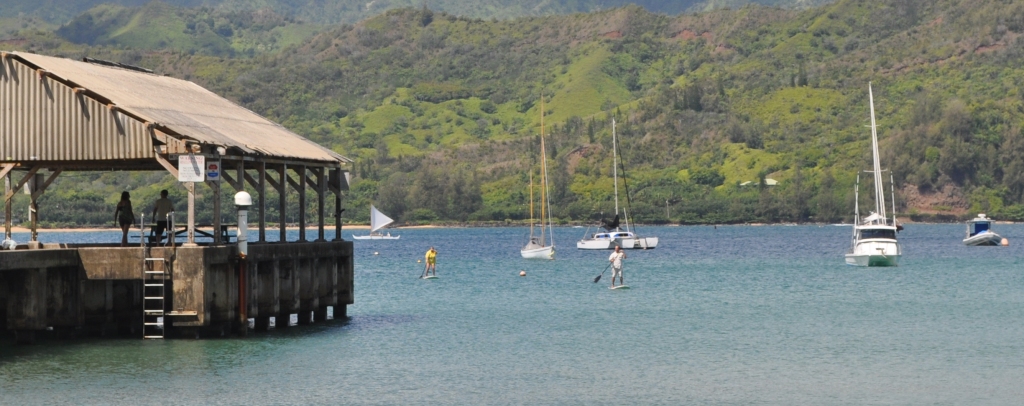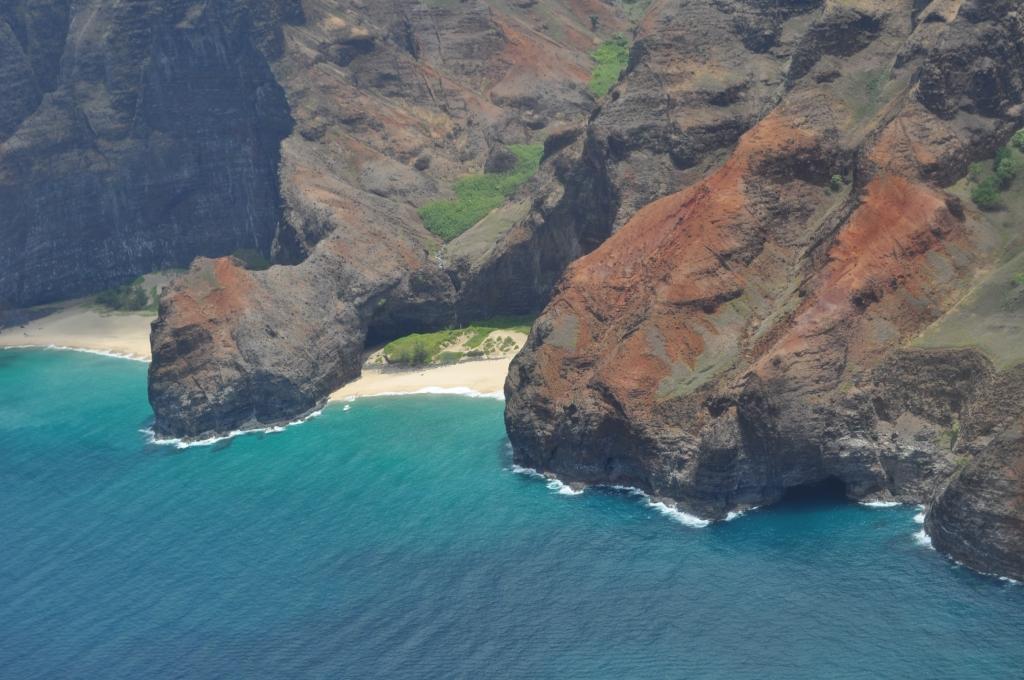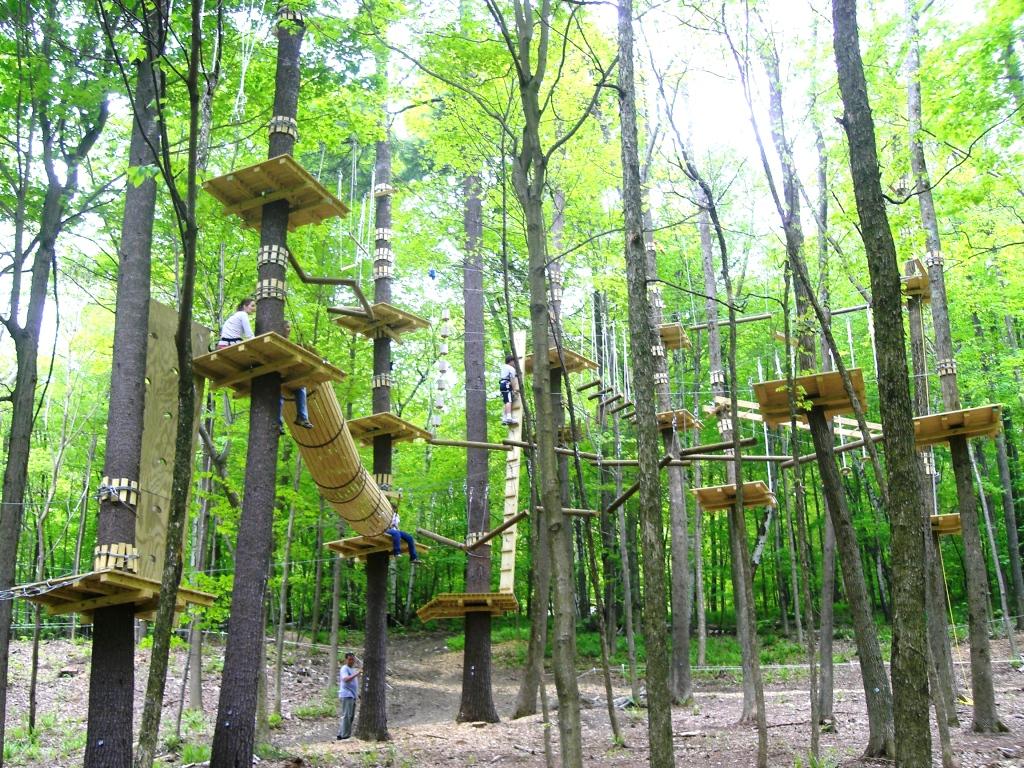
Standing up is not all that easy, just ask any infant.
Or a first time stand-up paddle boarder.
I can’t exactly remember being an infant, but if recent history with balance-related sports is anything to go by, I have to assume I was one of those babies who had to try to stand about one million time before finally getting it right. On a stand-up paddleboard, there is water — moving water — underneath you. Your center of gravity is high. Physics dictates the rest.
In Your Bucket Because…
- It’s the coolest new sport on the water…. and anyone can do it (so they say).
- It’s actual exercise.
- Hanalei’s river and bay are quiet gentle spots to try, with beautiful scenery to sit and gaze at when you need a break.
- Good for anyone, especially families and budget travelers (equipment is cheap to rent, and it doesn’t take much to get going).
And all this for a sport that does not look, to put it mildy, like it would be any shade of cool. Au contraire: it’s kind of geeky-looking: Something of a cross between surfing with both feet pointing forward, paddling like a canoer, and balancing like a Venetian gondolier.
Geeky-looking it may be, but stand-up paddleboarding is topping “things to do” lists in Hawaii and other tropical vacation destinations. It’s a fun, family-friendly beach activity, it seems less threatening and more accessible than surfing, and it is perfect for a Hawaii budget vacation.
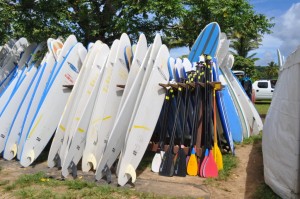 Small problem for me: Gravity. When it comes to putting boards to feet – surf boards, snow boards, skate boards, even windsurfers – the historical record is clear: I am a failure.
Small problem for me: Gravity. When it comes to putting boards to feet – surf boards, snow boards, skate boards, even windsurfers – the historical record is clear: I am a failure.
But I’m also a good sport, with that Charlie-Brown-kicking-the-football optimism that this time will be different. So I resigned myself to providing the afternoon’s entertainment for my small group of fellow travelers, and headed to Hawaiian Surfing Adventures in Hanalei, a surfing, kayaking, and stand-up paddle board outfitter, where the owner’s son, Mitch, promised I’d be up and paddling in no time.
Stand-up Paddle-Boarding in One Easy Lesson
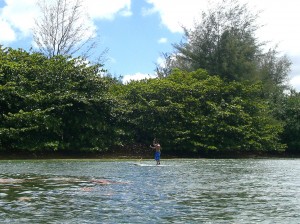
We started our lesson on land, with Mitch showing us how to move from lying to kneeling to standing. (I should point out that I’m middle-aged and not in the best shape of my life; younger, more flexible folks might find it easier to get up on a moving board from a prone position.) But okay, so far, so good; on dry land, we didn’t have to contend with moving boards, blowing winds, and nefarious waves sneaking up behind us. Everyone in our group of three managed to stand up, learn where to put our feet, and practice holding the paddles and moving them from one side to another.
Now we just had to do it with waves underfoot.
“It’s all about practice,” said Mitch, who twirled like a dancer on his board, easily jumping forward and back and spinning around. “When I started, I spent two weeks paddling up and down the river. You have to practice paddling, and turning, and even falling, and getting back up again.”
To me, the stand-up paddle boarding lessons resembled golf — one of those activities where body Part A has to go this way while Part B goes that way, while you manage bending this and balancing that, simultaneously changing positions and direction.
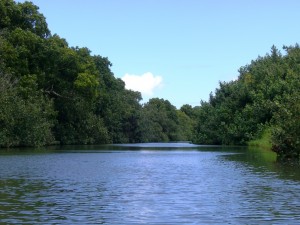
With the paddleboard, there is also that slight little problem of the board moving underfoot. In this respect, the Hanaeli River really is the perfect place to get your feet wet (and maybe the rest of you, as well). Most days, it flows so slowly that you can easily kayak (and board) it in both directions, although Mitch did warn us that we needed to keep an eye on the wind and tides (which he was kindly doing for us). Your body acts as a sail, which makes paddling upwind difficult, even for experts. But Mitch hadn’t lied when we said we’d all get up and get going: We might have been tentative, tenuously balanced, and mildly terrified, but indeed, within minutes, we were standing, and paddling, and for the most part, we were staying upright (the occasional exception being yours truly).
Paddle-Boarding on Hanalei Bay, Kauai
The quiet Hanalei River was a great practice ground. But inevitably, it was time to take our show on the road. After about half an hour, Mitch decided we were ready for Hanalei Bay. Surf was almost non-existent, but it was, sort of, open water, and as far as I was concerned, those little ripples could have been the breakers of Waikiki. I managed to stay upright through the first few, and then got plenty of practice falling (which, after all, Mitch had said was an essential part of the learning process).
When I got tired, I simply sat on my surfboard and drifted, looking at the shape of the Hanalei shoreline, which indeed is that of a dragon lying by the sea. You can see old Puff’s eyes and snout, and his spine and foreleg, all in the shape of the mountains surrounding Hanalei Bay.
When I’d rested long enough, I got up onto my paddle board one more time, pulled myself into the kneeling position, then stood up and balanced as a wave fluttered underneath. I kept my balance, bent my knees, and paddled forward. I survived another wave, and stayed upright, looking straight ahead toward the shore. Puff lay snoozing in the Kauai sun. As I paddled my way unsteadily back to the outfitter’s dock, I could swear I saw him wink.
Practicalities
Here are some tips from the folks at Hawaiian Surfing Adventures:
- Start on quiet water: a placid, slow-flowing river or a protected bay on a windless day.
- Spend as much time as you need kneeling on the board and paddling, to get a feel for balance, the water, and the paddling motion.
- Bent knees help with balance, and squatting and standing up as you paddle helps propel you forward using energy from your legs as well as your arms
- The faster you paddle, the easier it is to stay upright.
- Don’t be surprised if your core abdominal muscles become sore. They help with balance, and they get a workout.
- Check your position every once in a while to make sure it hasn’t shifted. Feet should be mid-board, the paddle needs to be facing the right direction, and you should be looking up and forward, not down..
- If you lose your balance try to drop into a kneeling position. If that isn’t possible, flop flat into the water so, if it’s shallow, you don’t hit the bottom too hard.
- Wear tape around your thumbs to prevent paddling blisters.
- Wear sun screen.
- A surfer’s scrape-guard shirt protects beginners from falling against the sand in shallow areas, and offers sun protection, as well.
